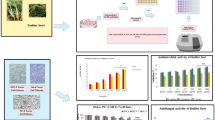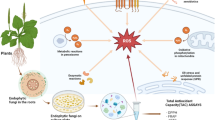Abstract
Crude methanol extracts of a marine sponge, Aaptos aaptos, collected from three different localities namely Kapas, Perhentian and Redang Islands, Terengganu, Malaysia, were tested in vitro on a pathogenic Acanthamoeba castellanii (IMR isolate) to examine their anti-amoebic potential. The examination of anti-Acanthamoebic activity of the extracts was conducted in 24 well plates for 72 h at 30 °C. All extracts possessed anti-amoebic activity with their IC50 values ranging from 0.615 to 0.876 mg/mL. The effect of the methanol extracts on the surface morphology of A. castellanii was analysed under scanning electron microscopy. The ability of the extracts to disrupt the amoeba cell membrane was indicated by extensive cell’s blebbing, changes in the surface morphology, reduced in cell size and with cystic appearance of extract-treated Acanthamoeba. Number of acanthapodia and food cup was also reduced in this Acanthamoeba. Morphological criteria of apoptosis in Acanthamoeba following treatment with the sponge’s extracts was determined by acridine orange-propidium iodide staining and observed by fluorescence microscopy. By this technique, apoptotic and necrotic cells can be visualized and quantified. The genotoxic potential of the methanol extracts was performed by the alkaline comet assay. All methanol extracts used were significantly induced DNA damage compared to untreated Acanthamoeba by having high percentage of scores 1, 2, and 3 of the DNA damage. Results from cytotoxicity and genotoxicity studies carried out in the present study suggest that all methanol extracts of A. aaptos have anti-amoebic properties against A. castellanii.



Similar content being viewed by others
References
Angerhofer CK, Pezzuto JM, Ko¨ nig GM, Wright AD, Sticher O (1992) Antimalarial activity of sesquiterpenes from the marine sponge Acanthella klethra. J Nat Prod 55:1787–1789
Aoki S, Kong D, Suna H, Sowa Y, Sakai T, Setiawan A, Kobayashi M (2006) Aaptamine, a spongean alkaloid, activates p21 promoter in a p53-independent manner. Biochem Biophys Res Commun 342:101–106
Arnoult D, Akarid K, Grodet A, Petit PX, Estaquier J, Amiesen JC (2002) On evolution of programmed cell death: apoptosis of the unicellular eukaryote Leishmania major involves cysteine proteinase activation and mitochondrion permeabilization. Cell Death Differ 9:65–81
Belarbi EH, Gomez AC, Chisti Y, Camacho FG, Grima EM (2003) Producing drugs from marine sponges. Biotech Adv 21:585–598
Bell PB (2004) The non-evolution of apoptosis. TJ 18(1):86–91
Brewitt H (1997) Contact lenses: infectious and hygiene. Ophthalmologe 94:311–316
Bruchhaus I, Roeder T, Rennenberg A, Heussler VT (2007) Protozoan parasites: programmed cell death as a mechanism of parasitism. Trend Parasitol 23(8):376–383
Collins AR (2004) Comet Assay for DNA damage and repair: principles, applications and limitations. Mol Biotechnol 26:249–261
Compagnone RS, Pina IC, Rangel HR, Dagger F, Suarez AI, Reddy MVR, Faulkner DJ (1998) Antileishmanial cyclic peroxides from the Palauan sponge Plakortis aff. angulospiculatus. Tetrahedron 54:3057–3068
Copp BR, Kayser O, Brun R, Kiderlen AF (2003) Antiparasitic activity of marine pyridoacridone alkaloids related to the ascididemins. Planta Med 69:527–531
Coutinho AF, Chanas B, Souza TML, Frugrulhetti ICPP, De Epifanio RA (2002) Anti Hsv-1 alkaloids from a feeding deterrent marine sponge of the genus Aaptos. Heterocycles 7:1265–1272
Diers JA, Bowling JJ, Duke SO, Wahyuono S, Kelly M, Hamann MT (2006) Zebra mussel antifouling activity of the marine natural product aaptamine and analogs. Mar Biotechnol 8:366–372
Diers JA, Ivey KD, El-Alfy A, Shaikh J, Wang J, Kochanowska AJ, Stoker JF, Hamann MT, Matsumoto RR (2008) Identification of antidepressant drug leads through the evaluation of marine natural products with neuropsychiatric pharmacophores. Pharmacol Biochem Behav 89:46–53
Dube A, Singh N, Saxena A, Lakshmi V (2007) Antileishmanial potential of a marine sponge, Haliclona exigua (Kirkpatrick) against experimental visceral leishmaniasis. Parasitol Res 101:317–324
Dudley R, Matin A, Alsam S, Sissons J, Maghsood AH, Khan NA (2005) Acanthamoeba isolates belonging to T1, T2, T3, T4 but not T7 encyst in response to increased osmolarity and cysts do not bind to human corneal epithelial cells. Acta Trop 95:100–108
Duke RC, Witter RZ, Nash PB, Young JD, Ojcius DM (1994) Cytolysis mediated by ionophores and pore-forming agents: role of intracellular calcium in apoptosis. Fed Am Soc Exp Biol J 8:237–246
Espino-Cantellano M, González-Robles A, Chávez B, Castañón G, Argüello C, Lázaro-Haller A, Martinez-Palomo A (1998) Entamoeba dispar: ultrastucture, surface properties and cytopathic effect. J Eukaryot Microbiol 45:265–272
Fatimah H, Nakisah MA, Ali AM, Aspollah S (2011) Surface morphological changes of pathogenic Acanthamoeba spp treated with mahanimbine. J Agrobiotech 2:81–83
Faulkner DJ (2001) Marine natural products. Nat Prod Rep 18:1–49
Gordeeva AV, Labas YA, Zvyagilskaya RA (2004) Apoptosis in unicellular organism: mechanisms and evolution. Biochem (Moscow) 69(10):1055–1066
Habsah M, Zalilawati MR, Shaari K, Latip J, Kikuzaki H, Lajis NH, Ali AM (2009) Antibacterial and DPPH free radical-scavenging compound from methanolic extracts of Aaptos sp. (Marine sponges). Pertanika. J Trop Agric Sci 32(1):45–52
Illingworth CD, Cook SD (1998) Acanthamoeba keratitis. Surv Ophthalmol 42:493–508
Kaczanowski S, Sajid M, Reece SE (2011) Evolution of apoptosis-like programmed cell death in unicellular protozoan parasites. Parasit Vectors 4:44–51
Lah B, Malovrh S, Narat M, Cepeljnik T, Marinsek-Logar R (2004) Detection and quantification of genotoxicity in wastewater-treated Tetrahymena thermophila using the comet assay. Environ Toxicol 19:543–553
Larghi EL, Bohn ML, Kaufman TS (2009) Aaptamine and related products. Their isolation, chemical syntheses, and biological activity. Tetrahedron 65:4257–4282
Laurent D, Pietra F (2006) Antiplasmodial marine natural products in the perspective of current chemotherapy and prevention of malaria: a review. Mar Biotechnol 8:433–447
Le Pape P, Zidane M, Abdala H, More M (2000) A glycoprotein isolated from the sponge, Pachymatisma johnstonii, has antileishmanial activity. Cell Biol Int 24:51–56
Lindquist TD, Sher NA, Doughman DJ (1988) Clinical signs and medical theraphy of early Acanthamoeba keratitis. Arc Ophthalmol 106:73–77
Marchan E, Arrieche D, Henriquez W, Crescente O (2000) In vitro effect of an alkaloid isolated from Amphimedon viridis (Porifea) on promastigotes of Leishmania mexicana. Rev Biol Trop 48(Suppl):31–38
Marciano-Cabral F, Cabral Guy (2003) Acanthamoeba spp. as agents of disease in humans. Clin Microbiol Rev 16:273–307
Martinez AJ, Visvesvara GS (1997) Free-living, amphizoic and opportunistic amebas. Brain Pathol 7:583–598
Mascotti K, McCullough J, Burger S (2000) HPC viability measurement: trypan blue versus acridine orange and propidium iodide. Blood Compon 40:693–696
Nakao Y, Shiroiwa T, Murayama S, Matsunaga S, Goto Y, Matsumoto Y, Fusetani N (2004) Identification of renieramycin A as an antileishmanial substance in a marine sponge Neopetrosia sp. Mar Drugs 2:55–62
Nakisah MA, Fatimah H, Ali AM (2008) Observation on the cytotoxicity of a plant compound labeled as MK2 on morphology of Acanthamoeba by scanning electron microscopy. Ann Microsc 8:72–75
Narendra PS (2000) Rapid communication: a simple method for accurate estimation of apoptotic cells. Exp Cell Res 256:328–337
Olive PL, Frazer G, Banath JP (1993) Radiation-induced apoptosis measured in TK6 human lymphoblast cells using the comet assay. Radiat Res 136:130–136
Prokosch P, Edrada RA, Ebel R (2002) Drugs from the seas current status and microbiological implications. Appl Microb Biotechnol 59:125–134
Rangel HR, Dagger F (1997) Antiproliferative effect of illimaquinone on Leishmania mexicana. Cell Biol Int 21:337–339
Rao KV, Kasanah N, Wahyuono S, Tekwani BL, Schinazi RF, Hamann MT (2004) Three new manzamine alkaloids from a common Indonesian sponge and their activity against infectious and tropical parasitic diseases. J Nat Prod 67:1314–1318
Rowland IR, Bearne CA, Fischer R, Pool-Zobel BL (1996) The effect of lactulose on DNA damage induced by DMH in the colon of human flora-associated rats. Nutr Cancer 26:37–47
Saraste A (1999) Morphologic criteria and detection of apoptosis. Herz 24(3):189–195
Schuster FL, Visvesvara GS (2004) Opportunistic amoebae: challenges in prophylaxis and treatment. Drug Resist Updates 7:41–51
Shaari K, Ling K, Mat Rashid Z, Jean T, Abas F, Raof S, Zainal Z, Lajis N, Mohamad H, Ali AM (2009) Cytotoxic aaptamines from Malaysian Aaptos aaptos. Mar Drugs 7:1–8
Singh NP, McCoy MT, Tice RR, Schneider EL (1988) A simple technique for quantization of low levels of DNA damage in individual cells. Exp Cell Res 175:184–191
Szenasi Z, Endo T, Yagita K, Nagy E (1998) Isolation, identification and increasing importance of free-living amoebae causing human disease. J Med Microb 47:5–16
Tepe B, Degerli S, Arslan S, Malatyali E, Sarikurkcu C (2011) Determination of chemical profile, antioxidant, DNA damage protection and antiamoebic activities of Teucrium polium and Stachys iberis. Fitoterapia 82(2):237–246
Wright CW, O’Neil M, Philipson J, Warhust D (1988) Use of microdilution to assess in vitro antiamoebic activities of Brucea javanica fruits, Simarouba amara stem and a number of quasinoids. Antimicrob Agents Chemother 32(11):1725–1729
Acknowledgments
This work was funded by Ministry of Science Technology and Innovation, Malaysia under Experimental Applied Research 01-02-12-0068-EA-10707 and Fundamental Research Grant Scheme (vote 59004).
Author information
Authors and Affiliations
Corresponding author
Rights and permissions
About this article
Cite this article
Nakisah, M.A., Ida Muryany, M.Y., Fatimah, H. et al. Anti-amoebic properties of a Malaysian marine sponge Aaptos sp. on Acanthamoeba castellanii . World J Microbiol Biotechnol 28, 1237–1244 (2012). https://doi.org/10.1007/s11274-011-0927-8
Received:
Accepted:
Published:
Issue Date:
DOI: https://doi.org/10.1007/s11274-011-0927-8




